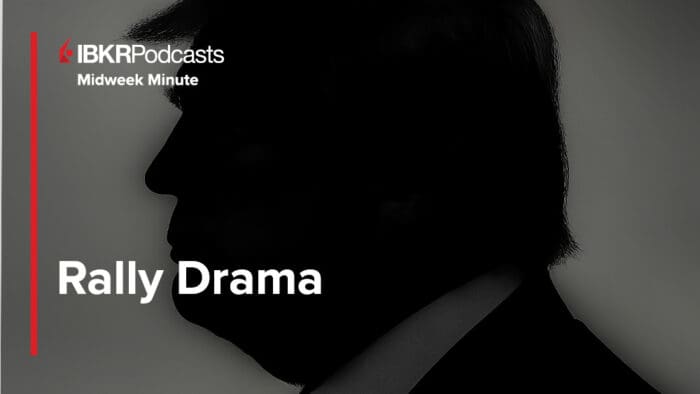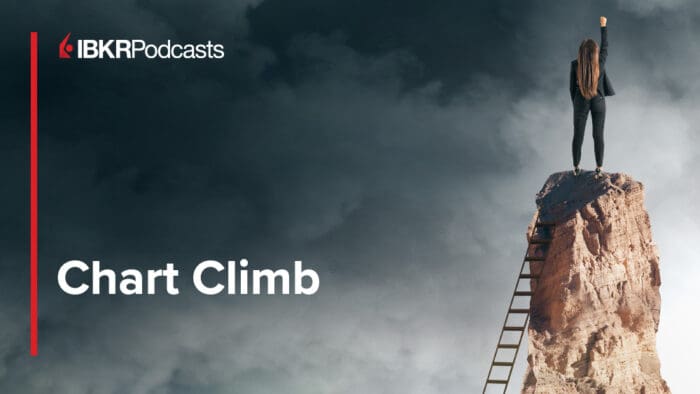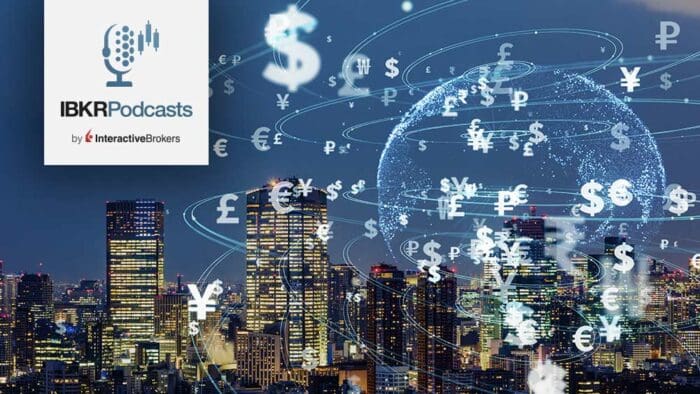Deborah Fuhr has watched the launch of ETFs since the industry began in the `90s. Today, Deborah keeps tabs on 10,652 products, 21,956 listings with assets of $9.1 trillion amongst 648 providers on 79 exchanges in 63 countries. Few industry watchers can claim to have her keen insight into the ETF world.
Sponsor’s website: https://etfgi.com/
Twitter: @deborahfuhr @etfgi
Note: Any performance figures mentioned in this podcast are as of the date of recording (September 30, 2022).
Summary – IBKR Podcasts Ep. 45
The following is a summary of a live audio recording and may contain errors in spelling or grammar. Although IBKR has edited for clarity no material changes have been made.
Andrew Wilkinson
Welcome everybody to today’s podcast from Traders’ Insight Radio. My name is Andrew Wilkinson and I’m delighted to have with me today, Deborah Fuhr, who is the managing partner and founder of ETFGI. Welcome Deborah, how are you?
Deborah Fuhr
I am great, thank you for having me on the show.
Andrew Wilkinson
You’re very welcome. Deborah is a fountain of knowledge on the ETF business and I’m just going to imagine for one second that we’re taking the 137 from Clapham Common to Marble Arch, we’re sitting on the top deck. Debbie, where does the ETF industry stand in 2022?
Deborah Fuhr
Well, to give you a sense of where we are, the first ETF was launched nearly 33 years ago. So, March 1990 will be the 33rd anniversary of the listing of the first ETF. And many people would think that product came apart from the US. It actually was listed in Canada, and it doesn’t exist any longer. The US had their first ETF almost 30 years ago, so pretty amazing to think about that. And that ETF was tracking a benchmark, the S&P 500, so, something everyone knows. And then Europe had their first products in 2000. So, there has really been a wave of innovation and a wave of seeing the ETF industry go from being kind of North American-centric to if you look at the end of August, we had ETFs … 10,652 products, 21,956 listings. The assets are at $9.1 trillion, 648 providers, they’re on 79 exchanges in 63 countries. So, we’ve had a very significant growth and I would say that we’re still in the early phases though. So, although 33 years or 30 or whatever you want to count it, I think that the use and adoption of ETFs is still early innings and will, I think, continue to grow quite significantly.
Andrew Wilkinson
How did we get here Debbie? Can you describe the evolution of the ETF business since the 90s?
Deborah Fuhr
Sure, and maybe to give you some perspective how I talk about this, I have been covering the ETF industry for over 25 years. So, of course, I still feel like I’m 25 years old, but I won’t tell you my age. But if I think back to when I started, there were 21 products and $8 billion and so, I was sitting on a trading floor in London at one of the global investment banks. My job was sales and marketing, so I would call people and they’d say, “I’m an active manager, I don’t want to use these things”. If you called advisors, they’d say, “Are you going to pay me rebates?” And I’d say no and they’re like, “Don’t come see me”.
So, who was using them in the early days was actually many traders and they were using them often because we had a family of sector ETFs in the US which allowed you to go both long and short and you didn’t have sector futures, so for many people, that was a really useful tool and so the early adopters were traders and now what we saw over time was, portfolio managers started to use ETFs to allow them to get access to markets that they didn’t cover all the time. So, for a long time, many people would say it doesn’t make sense to have exposure to Japan but when it did make sense, many investors would buy an ETF because they weren’t doing research and didn’t know what stocks to buy.
And then increasingly what we saw was fund selectors started to embrace ETFs because the array of products had grown and many people became aware of the fact that it is very difficult to find active funds, whether it’s ETFs or mutual funds or even hedge funds that consistently deliver alpha. And when you think about investing, typically, 7 out of 10 active funds are not delivering that alpha relative to their benchmark in any given year, and the ability to do that in a 3 or 5 or 10-year basis is even more challenging. So, most investors have employed this barbell approach to investing, where if they feel they can add value by buying their own securities, finding active funds, hedge funds, whatever, that deliver alpha, they’ll do that. And on the other side of the barbell, they are increasingly using ETFs and index products, and they don’t use the word “passive” intentionally. So, they use index products to do their asset allocation because 90% of the variation in returns comes from getting your asset allocation right. And so, they’re using ETFs to build that asset allocation, whether it’s being overweight, certain countries, certain styles, certain sectors, certain themes. And we’ve seen that as one of the big drivers.
And probably the other really unique thing about ETFs is they are probably the only democratic investment product that I’m aware of. And by that I mean every investor, whether it’s retail, institutional, or a financial advisor, has access to the exact same toolbox of products at the exact same annual costs and a very small minimum investment size. And we know that about half of the assets are held by hedge funds, pension funds, mutual funds, asset managers. So, it’s not that they’re available and they’re not used. It’s actually that all of these types of investors around the world are using these products.
Andrew Wilkinson
Debbie something that’s always not bothered me, but I always wonder why does one ETF gain traction and some others don’t? Is there a secret sauce here from the launch perspective?
Deborah Fuhr
That is a great question. I think the secret sauce is if you are the first mover to bring a product to market and it is the right time, you will win significant assets because people have to — often if you’re advisor or institution, you have to go to compliance to get approval. And so, as people are looking at products, if they see assets are growing, the ETF is trading a lot, more people start to use it. And once you start gaining assets, you gain trading volumes, other people pile in and so you’re basically setting the bar. You’re setting what the fee is going to be and you’re setting the benchmark and really you see significant growth. So, you know, I mentioned the first ETF in the US, that ETF still exists today and is still very actively traded. So unlike, consumer goods where normally you see innovation and people stop driving the old cars or maybe they have them but don’t really drive them because they’re antiques, innovation becomes better and today people are buying electronic vehicles.
What you see with ETFs is many of the original products are still used by a lot of investors and you can have new products come to market and they can be very similar and even be say, half the cost and you won’t see them become hugely more successful. And the reason for that is, once people already have money in a fund, it doesn’t make sense to sell that exposure to buy another product. You know, pay commission when you go out and when you go in, you potentially suffer market move, you potentially suffer capital gains and so there’s a lot of disincentives to not make a sale and purchase just to save a couple basis points. And so often when people do similar products, the “me too product”, they think “if I come out with a lower cost product, I’m going to win market share away.” Maybe you win net new money for some reason, but likely people continue to put money into that first mover ETF.
Andrew Wilkinson
Very difficult to dislodge somebody, I think is one way of summing that up, right?
Deborah Fuhr
Yes.
Andrew Wilkinson
So, are there fund families of fund launches whose success or failure has surprised you over time?
Deborah Fuhr
You know, there’s been a lot of launches and a lot of delistings, I think in the early days, a lot of firms were basically throwing spaghetti on the wall and seeing what stuck. So, there were a lot of things that didn’t work. I do think there have been cases where you know, Northern Trust was in the ETF industry and left it and came back and their initial set of products were all tracking local benchmarks, but local global benchmarks. And I think for many investors in the US, they’re probably not aware of all the different local benchmarks around the world. And so, it didn’t gain traction as quickly as I think they would have expected. I do think if they had stayed with it, and that’s the challenge, like how long do firms have an appetite to keep kind of staying with a product or a set of products? So, they ended up closing that but then they relaunched with a different set of products, different strategy and they become very successful.
So, sometimes you can have the right idea at the wrong time. I remember products coming to market giving exposure to a country where between the time of the idea and launch, political or economic things happen that made it unattractive for investors to want that exposure, and other times you just kind of get the right product at the right time. Like when the first gold product came to market, it took off amazingly well. So, I think it’s a little bit of luck and a little bit of figuring out what clients want and making sure that you put it in the right exchange at the right price point on the right benchmark and make sure you have the right sales and marketing strategy. And I think the sales and marketing strategy has become much more social media these days, especially after COVID and during COVID, I should say. I think investors are more inclined to look at what’s being said on shows like a podcast, what’s being said on TV, on the Internet, et cetera. So, I think it’s been interesting to watch the evolution of people going out and like carrying their book of ETFs, “Here’s my book from such and such ETF issuer.” Now it’s much more around social media and other forms of sales and marketing.
Andrew Wilkinson
Are there any stunning failures that come to mind? Sometimes you think this looks great, this is going to be a great product and then it flops. Is there anything that sticks out?
Deborah Fuhr
I think there’s times when you’ve seen those things, but not to the extent that just because there’s been so many products that have come to market and people decide to pare back their offerings. We did have a set of global ETFs for sectors here in Europe and I know a number of firms have been doing strategies like we’re doing sector rotation. So that was one that I thought was actually a very useful tool and I know that at the time, many of the institutions that have been using it were quite upset, so I think that could have stayed and continued to be a useful tool for investors. But that was one set of products that I think could have been better had they been left with a little bit more lead time to run.
Andrew Wilkinson
That’s spaghetti that didn’t stick to the wall very well, right?
Deborah Fuhr
Yes, unfortunately, some of it’s — well we’ve had ETFs like since it’s not around, I can maybe say it like people made ETFs that were based on religion. So, we’ve had like Catholics and Methodists and Baptist. We’ve had suppliers to Walmart. So, we’ve had a lot of interesting strategies come to market over the years, and they’ve been closed because it really didn’t resonate with the way investors think about investing, right?
Andrew Wilkinson
Right, right.
Deborah Fuhr
And I think the important thing is to remember if institutions are owning half the assets in ETFs then you have to think about, they care about benchmarks, they care about how well the ETF is tracking that benchmark, they care about the size, they care about liquidity, and so, all of those characteristics are really important when you think about ETFs from an institutional point of view which also then trickles down to advisors and retail.
Andrew Wilkinson
Let’s talk about adoptions. Some of the success is a function of the adoption amongst groups such as advisors, hedge funds, or robo-advisors. Can you speak to what fund characteristics work well with and with investors’ adoption of certain funds?
Deborah Fuhr
Yeah, and I guess robos were actually kind of an interesting segment. I think robos don’t get the credit for the adoption of ETFs that they actually have generated. And the reason I say that is if you think about the US, every day about 10,000 people turn 65 years old and most people in the US are not financial experts, so they often don’t feel comfortable talking to their friends and family about how much money they’ve earned or earning, saved, et cetera. So many will go to a robo-advisor to learn about asset allocation, about the benefit of buying lower-cost products and most robos use ETFs and so naturally, they’re becoming familiar with ETFs. The challenge is if that robo does not offer the ability to speak to someone in addition to being online and being anonymous, they often then go to an advisor because it’s awkward to make a big and important decision without being able to speak to someone. And so, we’ve seen that the firms that offer a hybrid model of robo plus the ability to speak to someone when you want to have gained significant assets.
And so, the normal idea would be you’d be offering exposures that would be kind of balanced portfolios … a little bit of equities and fixed income. You could have growth oriented, you could have dynamic, you could have low risk, moderate. So, they’re often pretty simple products and so what you find is for most investors they’re looking for plain vanilla exposures. Like most people know the S&P 500, so they probably have some money in that. They probably want some exposure into fixed income and maybe gold and so, I think that the low-cost building blocks have become very popular because when you look at the allocation of assets into different products, and if we looked globally, we can see that on average, the majority of the assets are in products that have an annual cost of between 0 and 10 basis points.
To give you a sense, I mentioned there is $9.1 trillion sitting in the ETF industry, if we look at that bucket, 0 to 10 basis points globally, there’s 592 products with $4.3 trillion and that is really significant. If you add in 10 to 20 basis points, there’s another 1,000 products and another $2.1 trillion. So, the majority of assets, but not products, are sitting in lower costs products and the majority of those are the plain vanilla basic building blocks. So, I think for many those have been the most popular products and the ones that if you were to look at where the assets sit, it is those benchmarks that everyone knows around the world.
Andrew Wilkinson
Let’s turn to crypto, and I’m thinking Bitcoin specifically. You’ve talked about the first mover’s advantage and how difficult it is to dislodge somebody or a particular ETF when it gets launched and adopted. Could you talk about the need, or otherwise, for more Bitcoin funds or more crypto funds in general?
Deborah Fuhr
Yeah so, it is interesting to look at the crypto landscape. So, we have a number of products in Europe. Actually, the majority of products are sitting in Europe. They’re all structured as exchange-traded products, so basically, they’re structured as notes, and they hold the underlying crypto assets. So, whether it’s Bitcoin, Ethereum, ether, or whatever, Bitcoin is the most popular. When we look at Canada, which came next in terms of issuing products, ETFs are regulated like funds and the regulator allowed them to do spot Bitcoin as a true ETF. When we move to the US, the regulator is not very comfortable with cryptocurrencies and Bitcoin and has only allowed the creation of Bitcoin using futures. It is a good example because if you look the first product came to market grew significantly in assets and trading volume and within the next two weeks two other products came to market and the assets and trading volume in those are significantly less than that first product.
Andrew Wilkinson
Yeah, do not attempt to dislodge.
Deborah Fuhr
Well, I think people will right ’cause then they try and a lot of the issuers of ETFs are building model portfolios themselves and trying to get platforms to put their models on. They’re offering for the advisor market to create model portfolios for them. So, if you are creating models and sticking your own ETFs and maybe some of other people’s in it, that is a way to grow assets. But on average it is as we’ve discussed very hard to dislodge the one that is to market first.
Andrew Wilkinson
So, my last question, Debbie, looking into your crystal ball, where does the ETF business go over the next five years?
Deborah Fuhr
That’s a great question. So, you know, there are segments of the world where there’s still not a level playing field. So, in many regions, take Asia as an example, the advisors are still paid to sell products and ETFs don’t pay people to sell them. So, you find that when the advisors are paid to sell, whether it’s mutual funds or structured products, or other types of financial instruments, they will focus on those ’cause they want to be paid money. Over time, like we had RDR here in the UK we’ve had Dutch RDR in Holland, no-fee products in the US, and in the US, we’ve seen significant growth because of the ability for retail investors and advisors to trade without paying commission on most platforms … the use of ETS has grown very significantly.
So, I think as we look at what’s happened in the US and think about how that could play out in other markets, I still think there’s real opportunity for ETFs to grow within the retail community globally. I think it’s also true that with advisors there is significant opportunity, and we are seeing that active ETFs, which today are only 5% of global assets are being embraced because remember, an ETF is a highly regulated fund. It’s either structured in Europe as a UCITS fund or in the US it’s a 1940 Act regulated fund with the added benefit of being listed in trade on exchange. And so inside of it, you can find index strategies, you can find active strategies, you can find smart beta, ESG, thematics and so, I believe that we’re going to see increasing use of the wrapper for active strategies in the US where ETFs are more tax efficient than mutual funds because of the in-kind redemption and we’ve been seeing that many of the mutual funds are converting from being a mutual fund into an ETF.
So, we are seeing some new entrants, firms like Dimensional Fund Advisors, Capital Group, T. Rowe Price to name a few, coming to market for the first time where when it was thought that ETFs only provided exposure to index strategies, they really didn’t want to play in that arena. They felt that was already owned by the top, biggest firms of BlackRock and iShares, Vanguard or State Street. And so, I think we’ll continue to see new issuers in the US. Once they come to the US because it’s not tax efficient for non-US investors really to buy US products, they often will then launch UCITS versions and those products can be sold in Europe, in Asia, in Latin America. So, my thought is we’re still in the early innings of adoption of ETFs, but also in terms of product development and the way investors will think about using ETFs going forward. Especially because there are also, as you said, going into crypto, which does resonate with a typically younger set of investors.
Andrew Wilkinson
Deborah Fuhr, managing partner, and founder of ETFGI.com over in London. Thank you very much for joining me today and to our listeners, tou’ll find more podcast content at ibkrpodcast.com and we look forward to speaking to you next time. Thanks very much, Debbie.
Deborah Fuhr
Thank you. Enjoyed being with you.
—
Related Links
Introduction to Exchange Traded Funds
Introduction to Exchange Traded Products (ETPs)
Understanding Leveraged and Inverse ETFs
Disclosure: Interactive Brokers
The analysis in this material is provided for information only and is not and should not be construed as an offer to sell or the solicitation of an offer to buy any security. To the extent that this material discusses general market activity, industry or sector trends or other broad-based economic or political conditions, it should not be construed as research or investment advice. To the extent that it includes references to specific securities, commodities, currencies, or other instruments, those references do not constitute a recommendation by IBKR to buy, sell or hold such investments. This material does not and is not intended to take into account the particular financial conditions, investment objectives or requirements of individual customers. Before acting on this material, you should consider whether it is suitable for your particular circumstances and, as necessary, seek professional advice.
The views and opinions expressed herein are those of the author and do not necessarily reflect the views of Interactive Brokers, its affiliates, or its employees.
Disclosure: ETFs
Any discussion or mention of an ETF is not to be construed as recommendation, promotion or solicitation. All investors should review and consider associated investment risks, charges and expenses of the investment company or fund prior to investing. Before acting on this material, you should consider whether it is suitable for your particular circumstances and, as necessary, seek professional advice.
Disclosure: Tax-Related Items (Circular 230 Notice)
The information in this material is provided for informational purposes only and does not constitute tax advice and cannot be used by the recipient or any other taxpayer to avoid penalties under any federal, state, local or other tax statutes or regulations, or to resolve any tax issue.
Disclosure: Bitcoin Futures
TRADING IN BITCOIN FUTURES IS ESPECIALLY RISKY AND IS ONLY FOR CLIENTS WITH A HIGH RISK TOLERANCE AND THE FINANCIAL ABILITY TO SUSTAIN LOSSES. More information about the risk of trading Bitcoin products can be found on the IBKR website. If you're new to bitcoin, or futures in general, see Introduction to Bitcoin Futures.
Disclosure: Futures Trading
Futures are not suitable for all investors. The amount you may lose may be greater than your initial investment. Before trading futures, please read the CFTC Risk Disclosure. A copy and additional information are available at ibkr.com.














Join The Conversation
For specific platform feedback and suggestions, please submit it directly to our team using these instructions.
If you have an account-specific question or concern, please reach out to Client Services.
We encourage you to look through our FAQs before posting. Your question may already be covered!